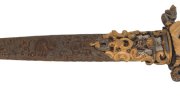Although its steel blade is sharp and pointed and capable of doing serious damage unsheathed, this 131/2-inch dagger was not meant to be a weapon. It is French, of cast bronze with gilded silver and engraved steel, and was crafted by an unidentified artist working sometime in the 1840s. Ivan Gaskell, Winthrop curator in the Harvard Art Museums, acquired the piece for the Fogg Museum in 2003 from David and Constance Yates, New York City dealers who specialize in nineteenth-century French sculpture.
Of extremely high quality, the dagger is, says Gaskell, “a wonderful product of the Troubadour movement in the arts in France in the years following the restoration of the monarchy: a Romantic fascination with medieval and Renaissance forms and myths. The movement was multimedia. Napoleon recognized the Middle Ages in the forms of his coronation. Ancient chivalric romances were published in adaptations by the Comte de Tressan and contributed to the rise of the troubadour style. In painting, the style showed up most often in realistic depictions of edifying historical events in smooth finishes and vibrant colors.” Think of some of Ingres’s paintings, Gaskell suggests, such as The Death of Leonardo da Vinci (1818) in the Louvre, in which the French king, Francis I, holding the dying Leonardo, “conspicuously wears a sword that might have accompanied the Fogg dagger.” Gaskell was drawn to the dagger because “it fits in with the Fogg’s early nineteenth-century French paintings and drawings, by Ingres in particular.”
The dagger evokes a Romantic mythology of the Renaissance most melodramatically by personifying Invidia, or Envy, one of the seven deadly sins, her legs and hair intertwined with serpents, in a manner that goes back to Giotto’s depiction of Envy in a fresco in the Arena Chapel in Padua, says Gaskell. Dedicated in 1305, the private chapel was built at the direction of the wealthy moneylender Enrico Scrovegnia, perhaps in penitence for his father’s sins, perhaps for his own. Enrico’s father is the usurer encountered by Dante in the seventh circle of Hell.
Personifications of virtues and vices, such as this one of Envy, Gaskell adds, were further articulated by handbooks of depictions derived from classical models (Roman coins, for example), by sixteenth-century compilers such as Cesare Ripa. A cook and butler for Cardinal Anton Maria Salviati and an aesthetician in his spare time, Ripa was later knighted for his influential emblem book, Iconologia, which gave allegorical substance to concepts and was quoted by painters, sculptors, poets, and orators for many years.
Gaskell mentions the French Romantic fascination with Shakespeare in general (“Think of Eugène Delacroix, who illustrated various of the poet’s works”). Here, Macbeth springs to mind: “Is this a dagger which I see before me, /The handle toward my hand? Come, let me clutch thee.” The dagger’s “self-referentiality—the personification plunges a dagger into herself—is,” says Gaskell, “a wonderful play on the susceptibility of a contemporary to imagine himself or herself taking on—horrifyingly—the attributes of Envy as he or she grasps the handle! It’s a pure artwork in that sense, not an embellished weapon, though it has the appearance of one.”











